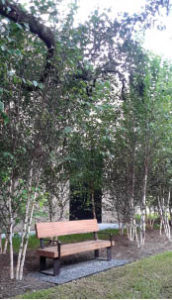Landscape Architect Thomas Woltz’s Cerebral Design at Rothko Chapel


Rothko could be high minded. He dumped his gallerist Sidney Janis because Janis represented that twerp Warhol. And he butted heads with architect Philip Johnson over the Rothko Chapel’s design. Rothko’s need to control his paintings’ presentation caused Johnson to depart the project. Why uptight? As a philosopher priest of the Abstract Expressionist movement, Rothko believed art’s dead serious purpose was to transform the viewer and evoke transcendence and the sublime. For John and Dominique de Menil’s chapel commission, he painted encompassing abstractions with large expanses of color which direct the viewer inward. Fifty years after it opened, the Rothko Chapel is undergoing a $30 million renovation and expansion to continue its mission as a meditative space which is also a venue for cultural and philosophical exchanges on themes such as social justice, in which the Dalai Lama and Nelson Mandela participated.

Landscape architect Thomas Woltz is fanciful shellac on the chapel’s expansion. Described as visionary, Woltz’s green spaces straddle an ambitious master plan. It prioritized repairing the building, to keep the art safe, one clue to the art’s value is an insane auction sale price of $86.9 million. It rejiggered the skylight (Rothko forbade spotlights), so evenly distributed light reveals tonal variations, and enhances the sanctuary’s atmosphere. The plan also includes a visitors’ welcome center with a gift shop and bookstore, an admin office, archives building, and a program and lecture center, unified by a courtyard.
You can learn a lot about Woltz from his other gigs. After being assailed by Hurricane Ike and a scorching drought, Memorial Park was a mess. Woltz designed a 10-year master plan to restore and revitalize the park. His plan required meticulous research into the land’s natural ecology, he dug into hydrology, into geology, wildlife, as well as public opinion, about 3500 Houstonians “weighed-in” on subjects like bathrooms. Key is to remove non-native invasive species, reforest, and reintroduce native plants so the park’s coastal plains, Post Oak Savannah, and Piney Woods remain resilient for centuries. His master plan’s “inaugural” phase, Eastern Glades, opened in July. It turned 100 acres of previously inaccessible land with geologic features that naturally trapped water into a lake and wetlands with walkways. A 30-foot land bridge to take pedestrians over Memorial Drive opens in 2022.
Equally important, Woltz researched the park’s history and culture to discover its “narratives,” for instance, archaeological findings revealed land use by Native American hunters, and by early settler cattlemen. The historical fact that World War I soldiers trained on the land before going to France where many perished, thus the park’s name, inspired Woltz to design a 90-acre “Memorial Groves” tribute to the dead.

Scientific and cultural investigations drove his work at Hudson Yards, the largest public space built in Manhattan in a century. Its gardens and pathways with reintroduced Hudson River native plants transform a godforsaken hole with operating trains, into human space. Woltz’s ecological restoration of the Maori’s New Zealand farmlands, devastated by deforestation, erosion, and overgrazing, resulted in the return of wildlife. To rebuild the Maori’s sacred burial ground, he reflected on their belief that spirit is in the plants, water, soil, and stones, and designed a ceremonial land bridge at their cemetery. One wonders however if the sculpture garden he built for the Peggy Guggenheim Collection in Venice entertains the narrative thread of Peggy sprawled naked on her palazzo roof.
Additional facts. Woltz was born on a tobacco and cattle farm near the Blue Ridge Mountains in rural Virginia. His University of Virginia professor Warren Byrd brought him into his firm, Nelson Byrd Woltz. Today Woltz (b. 1968) owns the firm. He has offices in Charlottesville, Virginia and New York, with field offices in Houston and Melbourne. He’s quick to say he couldn’t do what he does without his staff and collaborators, “extraordinary minds,” and “the most important asset in my life,” from varied disciplines, including anthropology and philosophy. A lightbulb moment was when a teacher said his design “sucked” because he had insufficient knowledge about the people who would use the space. Pivotal, he observed human use of piazzas and gardens while working for an architectural firm in Italy. This significantly expanded his definition of landscape. Not for him, the stale piety of pattern making.
Authenticity, Woltz told a Harvard lecture audience, should be his profession’s highest principle. It is a landscape architect’s duty, “moral obligation,” to learn the land’s historical and cultural story. Narrative is as crucial to design as scientific and ecological investigations.

But not at the chapel. Rather than narrative, Woltz told “Intown,” his design reinforces the experience Rothko tried to express. Communing with the paintings, Woltz went from being transported to “slammed with blazing sun and Houston heat.” He reminds us that Rothko never had the chance to see the finished chapel, and experience his vision. “He tried to replicate the quality of light in his New York studio, but couldn’t fully anticipate the Houston experience. To borrow a phrase from our architectural collaborators, Architecture Research Office, the work is somewhat of a ‘posthumous collaboration’ between designers and Rothko.” The new outdoor spaces, with the same meditative and reflective qualities as the chapel, serve Rothko’s vision.
A plaza with garden benches connects the chapel with the reflecting pool that holds Barnett Newman’s sculpture “Broken Obelisk.” While the Holly trees that tower over it and provide shade and comfort and invite reflection appear mature, the nearby multi-stemmed River Birchs that enclose meditative spaces are in “hair transplant phase” (Woltz’s term). Might take a few years for the new plants to look as formidable as the site’s native live oaks. The meditation garden west of the chapel will open in 2023. All said, not everyone gives a damn about contemplating the Absolute. Expect some to unleash dogs to splash in the reflecting pool and cause a ruckus.

























